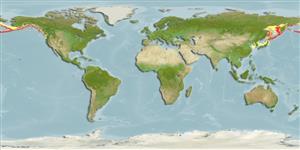Environment: milieu / climate zone / depth range / distribution range
पारिस्थितिकी
समुद्री ड़िमरसल; गहराई सीमा 20 - 1005 m (Ref. 50550), usually 400 - 600 m (Ref. 56390). Temperate
North Pacific: Hokkaido, Japan and Navarin Canyon in the Bering Sea to the Aleutian chain and the Gulf of Alaska.
आकार / वज़न / Age
Maturity: Lm ? range ? - ? cm
Max length : 21.1 cm TL पुल्लिंग / अलिंग; (Ref. 56390); अधिकतम प्रकाशित वज़न: 80.00 g (Ref. 56395); अधिकतम सूचित उम्र: 9 वर्षो (Ref. 56390)
पृष्ठीय रीढ़ (सम्पूर्ण): 7 - 8; पृष्ठीय सौफट रेज़ (सम्पूर्ण): 23-24; गुदा कांटा 0; ऐनल सौफट रेज़: 18 - 21. Body scales with serrated margin posteriorly; usually the ventral scale row present (Ref. 559). Infraorbital and nuchal spines strong; the uppermost spine of preoperculum bifid or trifid (Ref. 559). Enlarged pores along ventral margin of infraorbitals (Ref. 559). Nostril tube black (Ref. 559).
Life cycle and mating behavior
परिपक्व अवधि | पुनरुत्पत्ति | मछलीऔ का अंडे देना | अंडे | Fecundity | लार्वा
Masuda, H., K. Amaoka, C. Araga, T. Uyeno and T. Yoshino, 1984. The fishes of the Japanese Archipelago. Vol. 1. Tokai University Press, Tokyo, Japan. 437 p. (text). (Ref. 559)
IUCN Red List Status (Ref. 130435)
Threat to humans
Harmless
Human uses
मात्स्यिकी: कोई रुचि बग़ैर
अधिक जानकारी
आम नामउपशब्दचपायचयपरभक्षीईकोटोकसीकोलौजीपुनरुत्पत्तिपरिपक्व अवधिमछलीऔ का अंडे देनाSpawning aggregationFecundityअंडेEgg development
संदर्भजलीयकृषिजलीयकृषि रूपरेखाखींचआनुवंशिकीElectrophoresesहैरेटिबिलटीबीमारीप्रक्रमणNutrientsMass conversion
सहयोगीयोतस्वीरेStamps, Coins Misc.ध्वनिसिगुयटिरारफ्तारतैरने के प्रकारगिल क्षेत्रOtolithsदिमागदृष्टि
साधन
Special reports
Download XML
इंटरनेट स्रोत
Estimates based on models
Preferred temperature (Ref.
123201): 1.4 - 3.6, mean 2 °C (based on 77 cells).
Phylogenetic diversity index (Ref.
82804): PD
50 = 0.5000 [Uniqueness, from 0.5 = low to 2.0 = high].
Bayesian length-weight: a=0.00676 (0.00300 - 0.01523), b=3.17 (2.98 - 3.36), in cm total length, based on LWR estimates for this (Sub)family-body shape (Ref.
93245).
Trophic level (Ref.
69278): 3.5 ±0.4 se; based on diet studies.
लौटाव (Ref.
120179): माध्यम, न्यूनतम जनसंख्या दुगनी होने का समय 1.4 - 4.4 वर्ष। (Preliminary K or Fecundity.).
Fishing Vulnerability (Ref.
59153): Low vulnerability (11 of 100).
